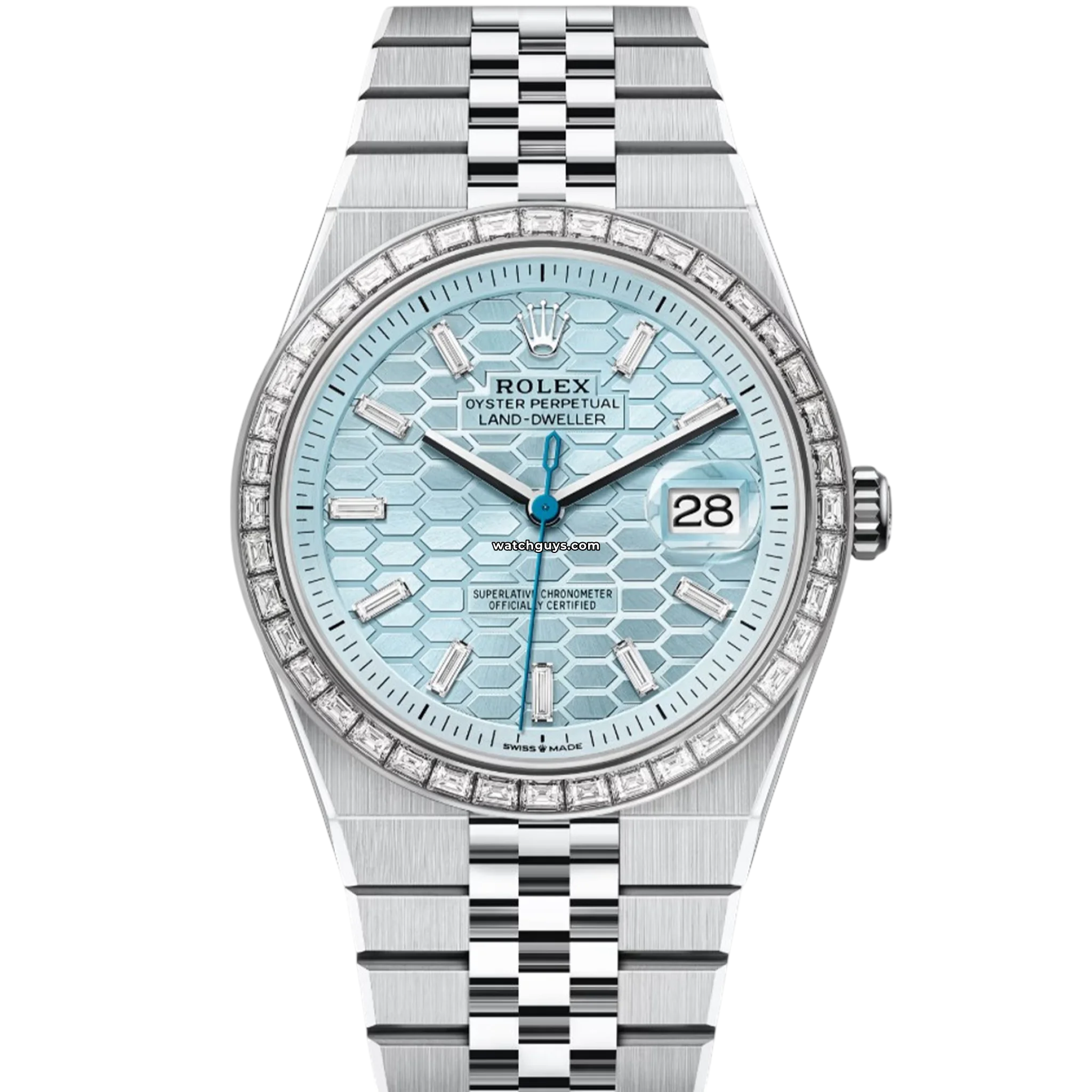Oysterquartz & Land-Dweller: Integrated Designs
The Rolex Oysterquartz and the new Rolex Land-Dweller represent two dramatically different eras in Rolex history. The Oysterquartz was Rolex’s bold response during the 1970s quartz crisis, while the Land-Dweller is a brand-new model that represents Rolex’s latest technical milestone.
By the end, you’ll have a clear understanding of how Rolex's 1970s quartz experiment compares with its 2025 successor, its influence on the Land-Dweller’s design, the physical and mechanical differences between the two, their price ranges in both retail and secondary markets, and how the Land-Dweller’s release has impacted Oysterquartz values.

The Rolex Land-Dweller 127334, a rare fusion of Oysterquartz heritage and modern engineering. Designed for those who roam beyond the map.
Oysterquartz History & Influence on the Land-Dweller
The Rolex Oysterquartz was introduced in 1977 as a response to the “Quartz Crisis.” With the watch industry shifting toward electronic movements and moving away from mechanical movements. This shift favored Japanese companies like Seiko, Casio, and Citizen, while the Swiss watchingmaking industry tanked. In response to the crisis, Rolex developed its own in-house quartz calibers; Caliber 5035 for the Datejust and 5055 for the Day-Date. These Rolex watches broke the mold with angular cases, integrated bracelets, and inventive styling far removed from traditional Rolex designs.
Though production was limited (fewer than 25,000 Oysterquartz watches were made), their bold, modern aesthetic left a legacy. That legacy was revived nearly five decades later with the release of the Rolex Land-Dweller at Watches and Wonders 2025. Rolex acknowledged the lineage directly, linking the Oysterquartz, Date 1530, and Datejust 1630 with the Land-Dweller in its launch materials.

The Rolex Oysterquartz 17013 Champagne where 1970s angular design meets quartz era precision in one of Rolex’s boldest departures from tradition.
As Rolex’s first new line in over a decade, the Land-Dweller continues the integrated bracelet look in a contemporary form. It is widely seen as a spiritual successor to the Oysterquartz, only now with the latest mechanical technology under the hood.
Design and Physical Differences
While the Oysterquartz and Land-Dweller share an integrated bracelet philosophy, their execution and visual identity differ significantly.
Case and Materials
The Oysterquartz came in a 36mm angular case—bold, tonneau-shaped, and unmistakably 1970s. It was available in stainless steel, two-tone (steel and yellow gold), and solid gold versions. The Land-Dweller, on the other hand, is offered in two sizes: 36mm and 40mm. It sports a slim 9.7mm profile and comes in stainless steel, rose gold, and platinum, with optional diamond bezels.
Bracelet and Integration
Both models feature integrated bracelets, but the designs reflect their eras. The Oysterquartz had an angular Oyster or Jubilee-style bracele integrated into the case. The Land-Dweller introduces the new “Flat Jubilee” bracelet. It is sleek, low-profile, and fully integrated with ceramic inserts and a hidden Crownclasp.
Dial Design
Oysterquartz dials were minimalist, with applied indices or Roman numerals, and featured “Oysterquartz” text. The Land-Dweller takes a modern approach with a laser-etched honeycomb texture, Explorer I style Arabic numerals at 6 and 9 o’clock, and the classic Cyclops date window. Platinum variants feature Rolex’s signature ice-blue dial, while others come in stark white with precious metal accents.


The Rolex Oysterquartz 17013 with a White Buckley dial (left), a sharp, retro-futurist icon of 1970s precision, contrasts boldly with the Rolex Land-Dweller 127235 (right), a modern rose gold model built for the horizon beyond the city skyline.
Rolex Oysterquartz vs Land-Dweller: Quick Comparison Table
| Feature | Rolex Oysterquartz | Rolex Land-Dweller |
|---|---|---|
| Production Era | 1977 – early 2000s | Released in 2025 (ongoing) |
| Case Sizes | 36mm only | 36mm and 40mm |
| Case Thickness | Approx. 11–12mm | 9.7mm (ultra-slim) |
| Case Materials | Steel, Two-Tone, 18k Yellow Gold | Stainless Steel, 18k Rose Gold, Platinum |
| Bracelet | Integrated Oyster or Jubilee | Integrated Flat Jubilee with Crownclasp |
| Movement Type | Quartz (Cal. 5035 / 5055) | Automatic (Cal. 7135, 5Hz, Dynapulse) |
| Display Caseback | Solid steel | Sapphire caseback |
| Dial Features | Classic layout, stick/Roman markers/rare Buckley dial | Honeycomb pattern, Explorer I style numerals |
| Accuracy | ±1 minute/year (quartz) | ±2 seconds/day (Superlative Chronometer) |
| Water Resistance | 100 meters | 100 meters |
| Retail Price | Discontinued | $15,350 – $118,050 (July 2025 MSRP) |
| Secondary Market | $5,000 – $25,000+ | $26,000 – $130,000+ (varies by model) |
Movement and Technology
One of the biggest differences between the Oysterquartz and the Land-Dweller lies at their heart: the movement.
Oysterquartz: Early Precision
The Oysterquartz, as the name implies, uses a quartz electronic movement; Rolex’s caliber 5035 (for Datejust) or 5055 (for Day-Date) introduced in 1977. These COSC-certified calibers offered remarkable accuracy (±1 minute per year), with an 11-jewel configuration and a stepper motor for the deadbeat seconds hand. Battery life typically lasted around two years, requiring minimal upkeep.
Land-Dweller: Innovation in Mechanics
The Land-Dweller debuts Rolex’s newest automatic movement, the Caliber 7135. This 5Hz (36,000 vibrations per hour) movement introduces the groundbreaking Dynapulse escapement, a dual silicon escape wheel system with direct impulse, reducing friction and increasing reliability. It boasts a 66-hour power reserve, a Syloxi silicon hairspring, and is certified to Rolex’s Superlative Chronometer standard (±2 seconds/day).
Automatic vs. Quartz Movements
| Model | Seconds Hand Motion | Power Source |
|---|---|---|
| Oysterquartz | Deadbeat (ticks once per second) | Quartz movement (battery-powered) |
| Land-Dweller | Smooth sweeping motion (5Hz beat) | Automatic mechanical (self-winding) |
In addition, the Land-Dweller is the first mainstream Rolex watch to feature a sapphire exhibition caseback. Usually only reserved for the off-catalogue Daytona models, it is a showcase of Rolex's technical artistry. Something the Oysterquartz (and most other Rolex watches) never offered.

The Rolex Land-Dweller's transparent sapphire caseback revealing the watchmaker's latest movement, the Caliber 7135. This display is a rarity.
Price Comparison: Retail and Secondary Market
Oysterquartz (Vintage Market)
As a discontinued model, the Oysterquartz is only available on the secondary market. Here's a breakdown of current market prices:
- Oysterquartz Datejust (Steel or Two-Tone): $5,000 – $8,000
- Oysterquartz Day-Date (Solid Gold): $12,000 – $25,000+
Prices vary depending on condition, originality, dial variants, and accompanying box/papers. The Day-Date versions are significantly rarer and more valuable.
Land-Dweller (2025 Release)
The Rolex Land-Dweller launched in 2025 and is available through authorized dealers through with long waitlists. Retail prices vary based on configuration:
- 36mm Stainless Steel: $14,450
- 40mm Stainless Steel: $15,350
- 18K Rose Gold: $43,000 – $47,400
- Platinum: $59,700 – $64,200
- Diamond-Set Versions: $90,000 – $118,000
Secondary Market Trends
Due to high demand and low supply, Land-Dweller watches have been trading at astonishing premiums:
- Steel models: $25,000 – $30,000+
- Platinum models: $88,000-$180,000 (Depending on size and diamond configuration)
The Land-Dweller’s release also brought renewed attention to the Oysterquartz, causing vintage prices to trend upward in 2025.

The Rolex Land-Dweller 127386TBR – the pinnacle of the collection, crafted in platinum with baguette-cut diamond bezel and markers.
Market Impact of the Land-Dweller on Oysterquartz Prices
With the launch of the Land-Dweller, Rolex drew attention back to the integrated designs of the 1970s. This spotlight has helped elevate interest in the vintage Oysterquartz line. Collectors now see it not just as a quirky footnote, but as a design predecessor to a cutting-edge modern Rolex.
Since the Land-Dweller’s debut, there has been increased inquiries and rising prices for Oysterquartz models, especially well-preserved ones with original boxes, papers, or rare dials. While it hasn’t triggered a speculative boom, it’s safe to say that the Land-Dweller added momentum to an already climbing market.
Final Thoughts
The Rolex Oysterquartz and Land-Dweller may be separated by nearly 50 years, but they share an unmistakable design lineage. One was Rolex’s bold leap into quartz precision during a time of crisis. The other is a confident, high-tech reinvention of mechanical watchmaking.
If you’re drawn to vintage character, angular casework, and quartz convenience, the Oysterquartz is a rare and affordable entry into Rolex history. If you crave the latest in movement innovation, a dress-sport hybrid aesthetic, and exhibition-worthy engineering, the Land-Dweller offers a truly modern Rolex experience.
In the end, both watches represent Rolex daring to do something different. Whether you prefer the tick of the past or the pulse of the future, each model has earned its place in the brand’s legendary lineup.





